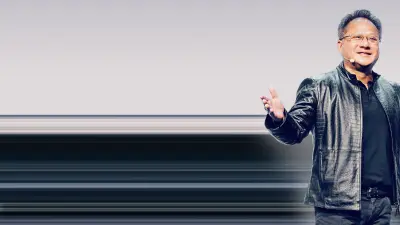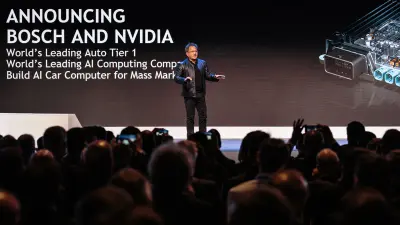Deep learning for autonomous driving
In dialogue with the CEO of NVIDIA

The driver will become a passenger in his own car. Artificial intelligence and deep learning will determine the mobility of the future, says Jensen Huang, co-founder, president and managing director of NVIDIA.
IoT expert Jensen Huang on AI, deep learning and autonomous cars

Loading the video requires your consent. If you agree by clicking on the Play icon, the video will load and data will be transmitted to Google as well as information will be accessed and stored by Google on your device. Google may be able to link these data or information with existing data.
“Deep learning has made it possible to begin mapping the entire world in HD.”
Intelligent machines are no longer science fiction
For many, NVIDIA is still best known for its work in the world of video games. But the graphics processing unit (GPU) NVIDIA invented in the late 1990s to drive computer graphics has recently found a new application: artificial intelligence. In broad terms, artificial intelligence and graphics are similar kinds of computing, both requiring large amounts of data to be processed at the same time. The GPU accelerates this kind of parallel processing very effectively, whether the application is graphics, high performance computing or artificial intelligence.
Several years ago, NVIDIA’s GPU computing model was discovered by researchers who were applying a technique called deep learning to rejuvenate the decades-old field of artificial intelligence. Deep learning allows software to learn from data, the machine equivalent of experience, but it requires an enormous amount of processing power to be practical. Thanks to GPU’s unmatched parallel processing capabilities, deep learning ignited the “big bang” of AI.
“AI is the most powerful technological force of our era,” says Huang. “Intelligent machines powered by AI computers that can learn, reason and interact with people are no longer science fiction. Today, a self-driving car powered by AI can meander through a country road at night and find its way. An AI-powered robot can learn motor skills through trial and error. This is truly an extraordinary time.” Autonomous vehicles can reduce accidents, improve the productivity of trucking and taxi services, and enable new mobility services.
“There are no truly autonomous vehicles on the road today.”
The car as co-pilot
Deep learning can train a car to drive, and ultimately perform far better — and more safely — than any human driver could do behind the wheel. It is a complex challenge that requires vast amounts of processing power, both in the data center where the car’s AI ‘brain’ is trained, and in the vehicle itself. Huang describes NVIDIA’s goal clearly: “We decided to build the world’s first single-chip processor that is designed for running deep learning algorithms at a rate that we can apply to autonomous vehicles.”
His vision is that “every single car will be autonomous.” “Your car is going to become an artificially intelligent co-pilot,” says Huang. By using sensor data from cameras and microphones inside and outside a car, AI can track the environment around the driver. This can be used in applications such as warning the driver of an obstacle they haven’t observed or tracking the driver’s attention to ensure they don’t become distracted. “It will be your guardian. It will overlook you and make sure that, even when you’re not driving, it’s looking out for you,” explains Huang.
“Enabling autonomous vehicles is an enormous undertaking. The challenge is huge, but so are the rewards.“
An enormous undertaking: AI-controlled autonomous driving
In March 2017, Bosch and NVIDIA announced they’re working together to develop a new AI self-driving car computer. Bosch produces the vehicle components and systems, while NVIDIA contributes the ‘brain’ of the autonomous car, its DRIVE PX computing platform. This system can process up to 30 trillion deep learning operations a second while drawing just 30 watts of power. It will enable auto makers to create vehicles capable of ‘Level 4 autonomy,’ where a car can drive on its own, without human intervention.
“It’s a great pleasure to partner with Bosch. Together, we can make our shared vision of the AI car a reality,” says Huang. “Creating the technology to enable autonomous vehicles is an enormous undertaking. The challenge is huge, but so are the rewards. This work will save lives, provide mobility to the disabled and improve urban design. Strong partners like Bosch are crucial to our success.” Huang envisions cars running autonomously as early as 2018, with the driver only being required to intervene in an emergency. “I think the timing is just about right,” he says.
Jensen Huang — Co-founder, President and CEO of NVIDIA

Jensen Huang was born in Taiwan and then moved with his family to Thailand before going to the USA to be educated. At high school, Huang discovered his passion for computers; he went on to study Computer Science at Oregon State University and did his Masters in Computer Science and Chip Design at Stanford. Together with Curtis Priem and Chris Malachowsky, he founded NVIDIA in 1993 with the goal of improving the graphics in video games.
Summary
Jensen Huang, CEO of NVIDIA, plans to develop a supercomputer that will make completely autonomous driving possible: “Together with Bosch, we can bring the future of an AI car to fruition,” he says — and hopes that this may happen as soon as 2018.